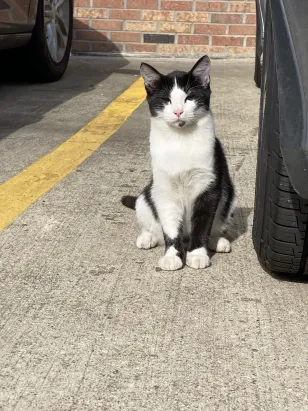When thinking of animals on Shawnee State University’s campus, there are a few that come to mind: the birds that fly overhead, the squirrels that run around to collect nuts, the service animals that assist their owners and even the university mascot, Shawn E. Bear. What if you were told that there was another animal commonly found? What if you were told that that animal was a cat?
Stray cats roam the grounds of SSU and interact with students. While they are seen in many places throughout the campus, the most common spot to find these cats is around the Campus View and Tanner Place apartments.
According to Ohio Animal Advocates (OAA), cats reside in 31% of Ohio homes and 26% of Ohio households feed stray cats.
While there is no official policy stating students are not permitted to take care of these stray cats, SSU students have been told not to.
“We’re told not to feed them or give them water,” said Aiden White, who has attended Shawnee for the past four years and has been a resident assistant (RA) for over two years.
The official policy for animals on Shawnee State’s campus in the SSU resident handbook states: “Pets and animals are prohibited in the residence halls, including the pets of any visitors.” The only exceptions to this rule are service animals and fish.
Despite instructions from RAs, some students still set out water and food for the stray cats. Donovan Owens, a 22-year-old senior at Shawnee, is one of these students.
“Someone’s gotta take responsibility,” Owens stated. During his two semesters of living on campus, Owens would feed the cats, play with them and give them water. Owens even said that he once helped a cat that had become trapped under the hood of someone’s car.
Owens isn’t the only one to offer assistance to the homeless animals. Residing under the staircases at one of the many Campus View apartments, is a homemade box made to provide shelter. It is unknown who provided the box, but no one seems to worry about taking it away.
The cats’ behavior is reported as either “timid” or “friendly.” To all that are asked, it seems as if the cats have become an enjoyable part of Shawnee State.
“I can’t think of anyone who doesn’t like the cats,” Owens claimed.
“Most people interact with them and like them,” White said, adding that some cats would follow him and other RAs while they walked rounds.
Testimonies from students and staff on Shawnee State’s campus suggest that the number of stray cats in the area range from low as five to as high as 30 in recent years. “I’d see three at a time,” Owens said.
“We think some are living under one of the buildings,” White stated. Several eyewitnesses have claimed to see cats crawling into a vent under one of the Campus View apartments.
The number of stray cats on campus does pose a question, though. What should be done about them? OAA supports the practice of trap-neuter-release (TNR).
TNR is non-lethal and a humane way to stop the growth of stray populations. OAA suggests TNR as a means to ensure that strays are vaccinated against rabies, become less aggressive and the overall welfare of the cats improves.
It’s unlikely that the number of stray cats on Shawnee’s campus will reach zero in the near future. In the meantime, all that can be done is what the people in the area choose to do.







Kay L • Apr 19, 2024 at 12:57 pm
We really do need a TNR program
There are many neighborhoods where there are feral and seemingly domesticated cats roaming and apparently being dropped off
They just keep reproducing it’s heartbreaking
Teresa • Apr 19, 2024 at 10:04 am
Our complex near SSU feeds cats.and birds.
I took in a stray that a resident threw out of her apartment.
She was abused too. Love her. She’s a great companion.